How To Make Money Blogging In 2024 (Beginner’s Guide)

Want to learn how to make money blogging? We’ve got you covered.
In this post, we’ll be sharing 16 strategies you can use to make money from your blog this year, and showing you how to get started with each of them.
We’ve included both tried-and-tested monetization methods and lesser-known strategies that you might not have considered.
No matter what your blogging niche is, you should be able to find something that works for your audience in the list below.
Note: Haven’t started your blog yet? Don’t worry. We’ve got you covered. Head over to our tutorial on how to start a blog to get a complete walk-through of the process.
1. Sell digital products
Hands-down the best way to make money from your blog is to use it to promote and sell digital products.

By digital products, I’m talking about things like ebooks, tutorials and guides, printables, apps, software, music, photography, graphics/digital art… anything that you can upload to your website and deliver as a downloadable file.
The reason selling digital products is such a great way to monetize is simple: It can earn you a ton of money.
Generally, you’ll earn a lot more selling directly to your audience than you would running ads or promoting affiliates.
And digital products are the easiest thing to sell, because you don’t need to purchase any stock or worry about things like shipping and inventory management.
Plus, the profit margins on digital products are sky-high. They cost almost nothing to make (other than your time) and can be sold an infinite number of times, so it’s pretty much 100% profit.
Now, let’s do some quick math here. Let’s say you create an ebook that resonates with your blog audience, and you start selling copies for five bucks each.
Next, let’s assume your blog gets 50,000 monthly visitors, and you promote your ebook to all those visitors through popups and ads in your sidebar, etc.
If just 1% of those visitors decide to buy the book, that’s 500 x $5. So you’d already be earning $2,500 a month in passive income. Crazy, right?
How to get started
Rather than selling your digital products on the same website you publish your blog posts on, I’d recommend setting up a completely separate ecommerce site.
Then, you can promote your ecommerce store on your blog to funnel traffic to it.
To build your site, it’s best to use an ecommerce platform designed for selling digital products.
We’d recommend Sellfy as it’s easy to use, affordable, and doesn’t charge any transaction fees.
Podia is another good option, particularly if you also want to sell memberships (more on this later).
Bonus tip: Not sure what to sell? Check out our roundup of the 12 best digital products to sell online for some ideas.
Related reading:
- How To Sell Ebooks Online: The Complete Beginner’s Guide
- How To Sell PDFs Online: The Complete Guide
- How To Sell Photos Online In 2023 (Beginners Guide)
- How To Sell Videos Online: The Beginner’s Guide
2. Sell online courses
Selling online courses to your readers is another really good way to make money from your blog.
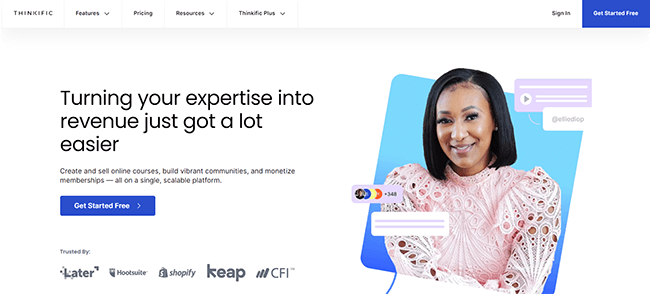
In some ways, it’s even better than selling digital products, because online courses have a higher perceived value than downloadable files, so you can charge more per sale.
According to data from Podia, the average online course price is $137. At those prices, you’d only need to make 8 sales to be earning over $1,000 per month. And if you’re getting thousands of visitors to your blog every month, that should be a cinch.
The key is to create a course that fits in with your blogging niche and is guaranteed to appeal to your audience. For example:
- Health/fitness bloggers could create a course that teaches the basics of nutrition.
- Digital marketing bloggers could create a course that teaches you how to do on-page SEO effectively
- Music bloggers could create a course that teaches you how to read music, produce beats, or play guitar
These are all fairly generic examples, but you get the idea. Think about who your blog readers are and what they might be interested in learning, and then go from there.
How to get started
Creating an online course isn’t as hard as you’d think.
The first step is to sign up for an online course platform. We’d recommend Thinkific as it has everything you need and more. Best part? They have a great free plan.
Once you’ve signed up, you can choose a course template and use the drag-and-drop course builder to start putting together your lessons and units.
Thinkific lets you add different types of media to your lessons, like text, video, downloadable files, etc. You can create quizzes and assessments, reward students with completion certificates, offer live lessons and coaching, and more.
Once you’ve created your course content, decide how you want to price it.
For example, you might choose to sell immediate access to all your lessons and units for a single one-time payment.
Alternatively, you could sell subscription memberships and drip out lessons week by week to your subscribers. This latter option is great as it gives you a recurring revenue stream.
After you’ve published your course with Thinkific, you can start promoting it on your own blog to drive traffic and sales.
3. Start affiliate marketing
Don’t want the hassle of selling your own products? Sell somebody else’s!
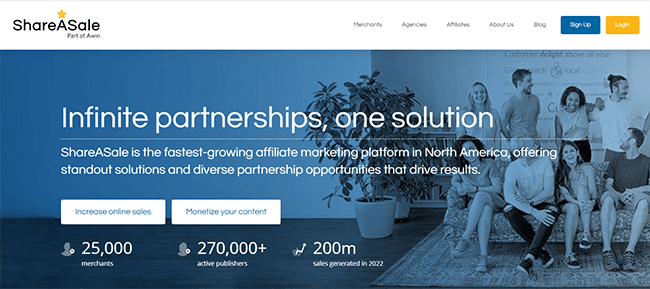
That’s the basic idea behind affiliate marketing: You promote another business’s products/services. And in return, you get paid a small commission on each sale you generate.
This also happens to be the method that the vast majority of bloggers use to earn the bulk of their income.
The most popular way to go about it is to create a niche affiliate site, publish blog posts around topics related to your chosen affiliate products (think product reviews, roundups, comparisons, buying guides, etc.), and insert your affiliate links inside those posts.
If readers click the link in one of your posts and buy the product (within the relevant cookie window), you’ll get paid for referring them.
The most successful affiliate blogs can make tens of thousands of dollars a month in affiliate income alone. It’s one of the easiest and most effective monetization strategies, and it works really well if you get it right.
How to get started
The first step is to find a good affiliate program.
And the best way to do that is to browse the listings on affiliate networks to see what’s available.
ShareASale is a good place to start. It’s one of the biggest affiliate platforms in the world and houses programs from over 4,500 merchants. So no matter what niche your blog is in, you should be able to find some offers worth promoting.
Most affiliate programs offer modest commission rates of 5%-20%. But it’s possible to find some that offer much higher rates than that (as much as 50%+ in rare cases).
If you already have a blog that gets traffic, make sure you pick an affiliate offer that your existing audience is likely to be interested in and insert your affiliate links in relevant posts that you’ve already published.
Then, start writing and publishing new blog posts optimized around keywords that likely buyers will be searching for. A review of the product you’re promoting is an easy win, so start there.
Bonus tip: SaaS companies tend to offer some of the best affiliate programs with the highest commission rates as they invest heavily in marketing.
4. Offer paid webinars & live streams
If you have a successful authority blog, your audience will probably see you as an expert in whatever niche you write about.
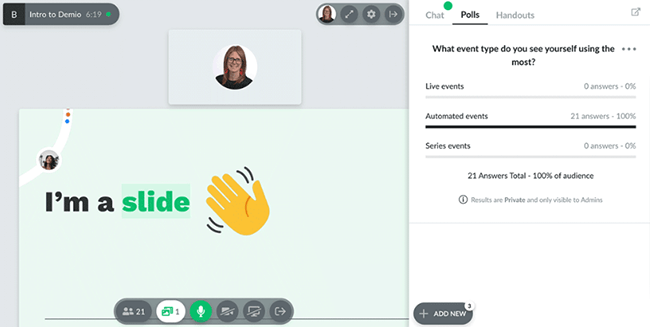
You can capitalize on that by regularly hosting pay-to-attend webinars or live streams.
For this one to work, you’ll need to share advice that’s extremely valuable to your readers in your paid webinars—something that’s worth paying for. The higher the registration cost, the more value you’ll need to offer.
An easy way to increase the value of your webinars is to promise to fit in a Q&A session at the end.
There’s a good chance a lot of your blog readers will have questions about particular topics that they’d love to ask you, and a live Q&A session gives them the opportunity to do that.
How to get started
First, you’ll need to sign up for a webinar platform. You’ll use the platform’s software to host your streams and collect & manage registrations.
If you’re not sure which platform to choose, head over to our post on webinar platforms to find something suitable to your needs.
Most platforms offer a landing page builder to create your webinar registration page (with payment processing integration so you can take payments at the point of registration).
Then, promote your webinar on your blog to drive traffic to those pages.
5. Start an ecommerce store
If you want to start making the big bucks, and you’re willing to put in a bit more effort, then you might want to branch out into ecommerce.

Building an ecommerce store and selling physical products is a lot more work than selling digital products, courses, and webinars.
However, it’s very scalable and the earning potential is much higher. If your store takes off and becomes super successful, you could be earning as much as seven figures a year (or more).
Initially, you can use your blog to drive inbound leads to your store.
Plus, blogging will also help you to build topical authority in your niche and accrue backlinks that’ll improve SEO and give your store and product pages a better chance of ranking in Google Search.
But once you’ve built up that customer base, you should be able to take a step back on the blog and expand out into other marketing channels like PPC, social media, etc.
How to get started
You have two options here:
- Add ecommerce functionality to your existing blog (for example, if your blog’s built on WordPress, you could do this by installing an ecommerce plugin like WooCommerce)
- Create a brand new ecommerce store from scratch and start blogging to drive traffic to it.
We’d recommend the latter.
You’ll need an ecommerce platform to build your store.
Shopify is the leading ecommerce platform and a good choice for most users. However, Sellfy is much easier to use and the best choice if you’re looking for simplicity.
Once you’ve built your store, the next step is to start filling out your product catalog. Obviously, you’ll want to focus on products that make sense for your target blog audience. But you’ll also need to think about things like market demand, competition, profit margins, etc.
For help choosing what products to sell, check out our roundup of the 26 best products to sell online this year (according to data).
6. Sell print-on-demand merchandise
An easier way to monetize your blog through ecommerce is to sell print-on-demand (POD) merchandise.
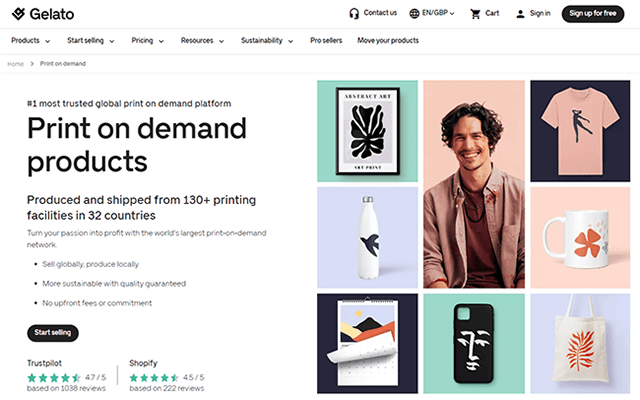
Examples of POD merch include branded t-shirts, hoodies, stickers, mugs, tote bags, or phone cases.
If you go down this route, you’ll still be selling physical products to your blog audience, but you don’t have to worry about anything like manufacturing, shipping, or inventory management.
The print-on-demand company you work with handles all that stuff, so it’s much more hands-off.
Plus, you don’t have to buy any stock upfront either, which makes it pretty much risk-free.
Products are printed and shipped on demand by the company you partner with, and you only pay them after the customer has already paid you.
How to get started
The first step is to sign up for a print-on-demand site.
There are lots of options to choose from, but we’d recommend Gelato. It has a great product catalog, good prices, and excellent printing quality.
Next, you’ll need to connect Gelato (or whatever other POD provider you chose) to your blog/online store.
After that, browse their product catalog and pick out some items to sell.
Then, customize those products by uploading designs to them (for example, you could add your blog logo to create a branded t-shirt).
Finally, import the products you’ve created to your website, set your prices, and start selling them through your blog.
When a customer purchases one of your products, the order is automatically sent to the print on demand company. They print it at the nearest production center to the customer and then ship it out to them. Afterward, they bill you for the base product and fulfillment cost.
The difference between the amount your customer pays you and the amount you pay your POD provider is your profit margin.
7. Start a dropshipping business
Dropshipping is another sub-type of ecommerce.
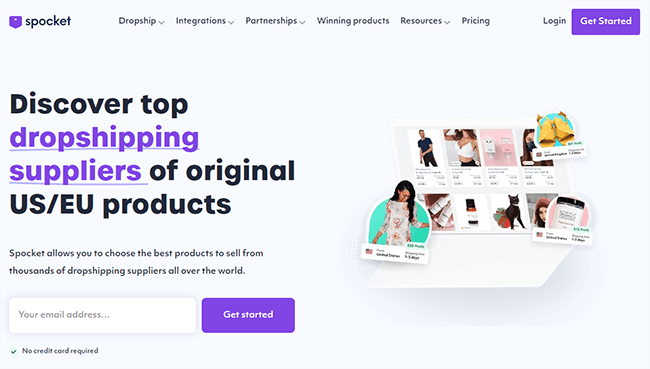
It’s similar to print-on-demand in that you don’t have to purchase any stock up front and your supplier handles fulfillment.
But instead of selling custom merchandise printed with your designs like you would with print on demand, you’ll be selling regular products.
Once you’ve set it up, you can start blogging to drive traffic and inbound leads to your dropshipping store.
How to get started
First, you’ll need to sign up for a dropshipping platform.
We’d recommend Spocket. It has a huge range of products from thousands of merchants and dropshipping suppliers, and it integrates easily with WordPress/WooCommerce, Shopify, and most other CMS/ecommerce platforms.
Once you’ve signed up for a dropshipping platform and connected it to your website, you can browse their catalog to pick out products to sell and add them to your store.
Then, set your markup, and start selling. As you make sales, you can send the order details through to your suppliers in a couple of clicks, and they’ll ship the products directly to the customer.
You can use your blog as a marketing channel to drive leads and sales opportunities. Publish blog posts targeting buyer-intent keywords related to your niche, then set up a funnel to get visitors who click those posts to check out the products you sell.
8. Collect donations from your readers
Asking for donations is one of the most ethical ways to make money blogging because you’re not selling anything, or shoving ads and offers in your reader’s faces.
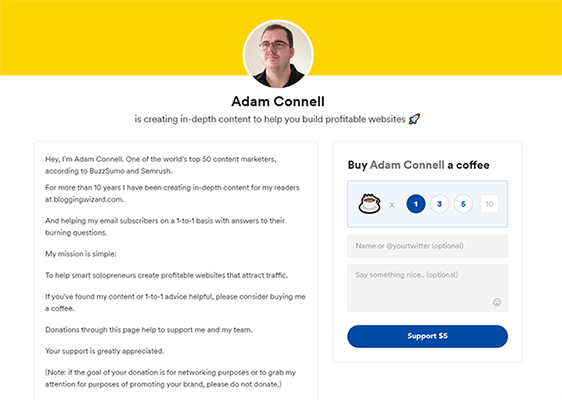
Instead, you’re offering valuable content to them for free, and giving them the option of supporting you if they want to give something back.
Yes, it’s not a foolproof strategy, as you’re relying on the generosity of strangers. But you’d be surprised at how often readers donate if you make it easy for them to do so.
That said, to maximize your donations, it helps to focus on building a strong relationship with your readers. Because readers who feel like you genuinely care about and value them are much more likely to donate.
Here are some tips on how to build that relationship:
- Make sure all your blog posts are genuinely helpful and provide real value.
- Be personable in your writing and show that you’re a real human, not just a faceless publisher.
- Open up your comments section and invite readers to leave their thoughts below each post you publish
- Take the time to respond to all your comments to build that connection.
- Have a contacts page where your readers can get in touch, and respond to all your emails
How to get started
The easiest way to collect donations on your blog is to create a page on Buy Me a Coffee, then link to it in your posts, website footer, or sidebar.
It’s free and it only takes a few minutes. Just head to the site, enter your name for the URL, and click Start my page. Then, follow the instructions on-screen to set it up.
Once your page is live, your readers can visit it to buy you a coffee (donate $5), or multiple coffees if they’re feeling particularly generous
Bonus tip: Want to see what it looks like in action? Check out Adam’s Buy Me a Coffee page, where readers of Blogging Wizard can donate if they’d like to support the site.
9. Display ads on your blog
Displaying ads on your website is one of the easiest ways to monetize your blog.

However, you’re unlikely to make much money from it until your blog has a significant amount of traffic. Particularly US-based traffic.
The way it typically works is that bloggers sign up for an ad network (like Google Adsense), then paste an ad code on their site and choose where they want ads to appear.
Then, the ad network will start matching advertisers to your site based on your content and visitors and displaying relevant ads in the spaces that you made available.
If your ad network pays per click (as is the case with Google Adsense), then the amount you’ll earn will depend on the number of visitors to your blog who click on the ads. We call this CPC (cost per click).
If your ad network pays based on impressions (CPM), then your earnings will depend on how many people see the ads.
To work out how much you could potentially earn from display ads, we can look at RPM (revenue per mille). It’s a metric that tells you how much money you make per 1,000 page views.
The average RPM from Adsense is around $5-$10 for broad niches but can be much higher than that for more competitive niches with a high CPC.
That means that if your blog gets 10,000 pageviews every month, you can expect to earn around $50-$100 in monthly ad revenue from Google Adsense. If it gets 100,000 page views, expect to earn $500-$1000 in monthly ad revenue.
How to get started
The easiest way to get started with ads is to sign up for Google Adsense.
It doesn’t have any pageview eligibility requirements, so it’s a good choice for new blogs that don’t have a lot of traffic yet.
However, Google Adsense doesn’t offer a very good RPM. So once you’re getting a good amount of traffic, it’s probably worth switching to a better ad network.
Monumetric is a very good option. You’ll be eligible to sign up at 10,000 monthly page views. Raptive may be even better, but you’ll need 100,000 monthly page views to apply.
Check out our roundup of the best ad networks for a full breakdown of all your options and their eligibility requirements.
10. Offer paid product reviews
This one’s similar to selling guest posts in that a third party pays you to publish a particular post to your blog.
But unlike with guest posts, they won’t be writing the content—you will. And that content will be a review of one of their products.
For example, let’s say you blog about PC peripherals. In that case, a company might reach out to you and ask you to review a new keyboard that they’ve just launched.
In exchange, they’ll pay you a fee for the post and send you a free product for you to test.
Again, it’s up to you how much you charge for paid product reviews.
You could charge a one-off fee of $100-$1,000+ for the post, or agree on some sort of commission structure where you’ll get paid based on how much traffic/sales your post generates for their business. Or you could do a mixture of the two.
How to get started
This one’s easy: Just start a blog in your chosen niche, publish high-quality content (make sure that includes product review posts), and work on getting traffic.
At some point, the chances are that brands/companies in your niche will find your blog and reach out.
Make it easy for them to do so by having a clear contact page with an email address for business inquiries.
11. Turn your blog posts into YouTube videos
Another indirect way to make money blogging is to make YouTube videos from your blog posts.
If your blog posts are already ranking for your target keywords on Google and bringing in website traffic, your YouTube videos could do the same on YouTube search and bring in views.
Then, you can monetize those views through video ads, paid sponsorships, YouTube live streams, and promoting affiliate offers in your videos.
How to get started
First, create a YouTube channel and fill it out with a banner, profile picture, and channel description.
Then, take some of your most popular blog posts and convert them into video scripts.
You can do this manually. Or to save time, use AI writing tools to automatically convert them for you in seconds (you might want to edit them to polish them up afterward).
Grab some recording equipment, record your videos, edit them, and upload them to your channel.
Don’t forget to add a CTA to the end of each video inviting viewers to subscribe to your channel.
When uploading, make sure you include your target keywords in the video title, tags, description, etc. for SEO purposes. And optimize your thumbnail to make it as ‘clickable’ as possible.
If you want, you can embed your YouTube videos in your blog to help get the ball rolling and bring in some initial viewers.
Once you reach 1,000 subscribers, you should be eligible to apply to the YouTube Partner Program and earn ad revenue on your videos.
Read our guide on YouTube monetization for more information.
12. Use your blog to promote your socials
Another way to make money blogging is to use your blog as a vehicle to grow your social following.
Then, once you’ve got a good amount of followers, you can make money through your social media accounts separately through brand sponsorships.
This is a great way to diversify your income streams so you’re not relying solely on your blog and instead have monetized audiences on multiple channels bringing in revenue.
How to get started
The easiest way to do this is to add a CTA to all your blog posts asking visitors to follow you on social.
But if you want to get the best results, it helps to offer some sort of incentive.
For example, you could set up a giveaway in which users have to follow one of your social profiles in order to be entered for a chance to win a prize.
Then, you can host the giveaway on its own landing page on your blog website, and promote it through a triggered popup that appears to all your site visitors.
Check out these posts for advice on how to monetize your social audience once you’ve grown your following:
13. Set up a paid newsletter
This is another great way to set up a profitable blog and make money online.
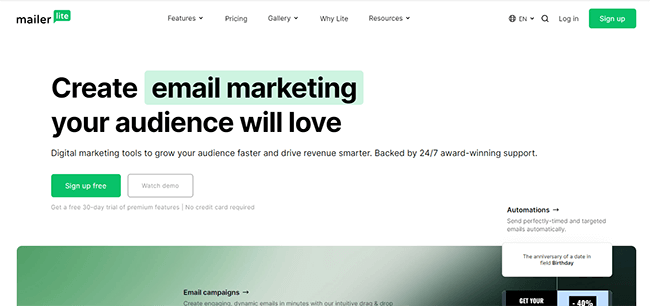
Newsletters are periodic emails that you send out to your subscribers.
A lot of bloggers offer a free newsletter to keep their audience informed about their latest posts.
But you can also offer a paid newsletter, in which you share exclusive, premium content with subscribers in exchange for a monthly subscription fee.
How to get started
You’ll need to sign up for an email marketing platform that supports paid newsletters
MailerLite is perfect for this. It gives you everything you need in one place.
You can use MailerLite to create opt-in forms and landing pages to build your list, ues its drag-and-drop newsletter builder to put together your emails, set up automations, and collect recurring payments from your subscribers.
Bonus tip: If you’d prefer not to sell paid newsletters, it’s still worth building a mailing list anyway, as you can monetize your free newsletter by sending out affiliate offers to your subscribers.
14. Set up a paywall
Another option is to gate your best blog content behind a paywall.
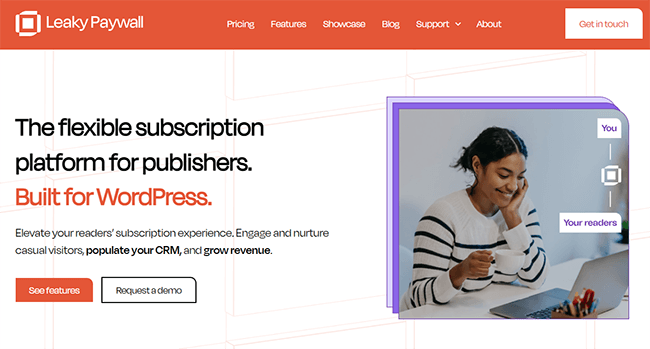
Then, you can sell memberships that give visitors access to that exclusive content in exchange for a monthly subscription fee.
Just keep in mind that there are a lot of blogs out there that offer really good free content.
So if you want to convince visitors that your content is worth paying for, it has to be really, really good stuff that they can’t get for free anywhere else.
Case studies and original research are examples of the kinds of blog posts that might be valuable enough to charge for.
How to get started
If you use WordPress, the process to get started will be fairly easy.
You’ll need to install a plugin like Leaky Paywall or Memberful.
15. Sell your blog
A final way to make money blogging is to simply build a successful blog and then sell it to somebody else.
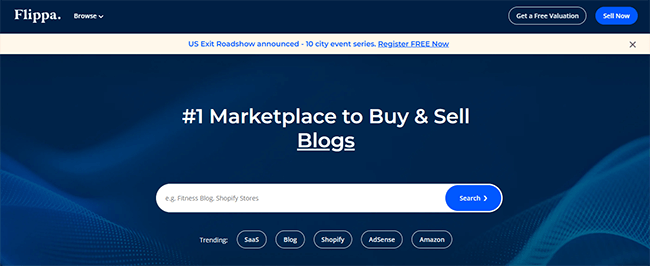
If your blog gets a good amount of monthly pageviews and/or revenue, selling it will give you a huge cash injection that you can then reinvest elsewhere.
But obviously, the tradeoff is that you’ll no longer be able to use your blog to earn monthly recurring revenue.
How to get started
You can list your blog for sale on a website flipping site like Flippa or Empire Flippers.
Typically, the price websites are sold for is determined by multiplying their net monthly profit by a set multiplier, which could be anywhere from 10x-50x.
For example, let’s say your blog earns $1,000 a month in net profit. You might be able to sell it at a multiplier of 30x if it’s in a profitable niche and there are no red flags, in which case you’d list it for $30,000.
If your blog was earning $5,000 a month in net profit and you sold it at a 40x multiplier, you’d make $200,000.
Make money blogging FAQ
How do beginner bloggers make money?
Most of the monetization methods in this post are suitable for beginner bloggers.
That said, the easiest three ways to make money when you’re just getting started are probably Google Adsense, affiliate offers, and donations.
Once your blog is more established and you get a good amount of traffic, you can try selling digital products, merchandise, and guest posts. And you should be able to sign up for better ad networks that pay more but have higher eligibility requirements too.
Can you make $1,000 a month with a blog?
Yes, it’s very possible to make over $1,000 per month through a blog. The most successful bloggers can earn more than 10x as much as that.
How long does it take to make $1,000 per month blogging?
There’s no definitive answer to this question. That said, generally, you should see blogging as a long-term strategy.
It can take a year or so for your blog to break out of the Google sandbox and for your posts to start ranking.
But as long as you’ve done careful keyword research and you’re publishing high-quality content that’s well-optimized, you should start getting traffic eventually.
Once you’re getting 10,000+ monthly pageviews from search engines and other sources, it should be achievable to make $1,000 per month, but it depends on how profitable your blog niche is and your monetization strategy.
How do bloggers get paid?
It depends on how you’ve monetized your blog. You may receive payments via PayPal, international bank transfer, or cheque. Most ad networks and affiliate programs use monthly payment cycles.
Final thoughts
That concludes our beginner’s guide on how to make money blogging in 2023. We hope you found it useful.
No matter what monetization method you use, the key to making money blogging is traffic.
Your main priority should be to publish great content, optimize your blog’s SEO, and generate as much organic search traffic as possible. The more qualified traffic you have, the more money you’ll make.
While you’re here, here are some other posts you might enjoy:
- The Best Ways To Monetize Your Blog (And Why Most Bloggers Fail)
- 13 Ways To Make Money From A Website (And How To Get Started)
- How To Make Money Gaming: 11 Proven Methods
Disclosure: Our content is reader-supported. If you click on certain links we may make a commission.
